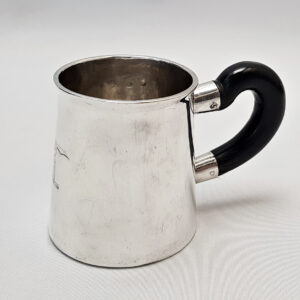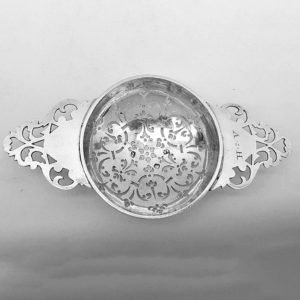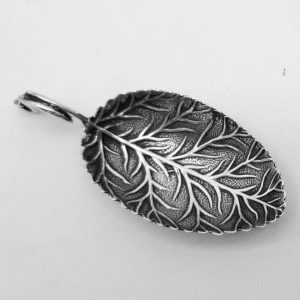Tea Accessories
Tea Accessories
Browse our collection of antique silver Tea Caddy Spoons, Teapot Stands, Tea Strainers, Spoon Trays etc. After tea was first introduced into England in the late 17th century women adopted the drink for their social gatherings and served tea after dinner. It was also an occasion to demonstrate wealth and good taste by showing off their complement of silver teawares. “Afternoon tea” in Great Britain was established by the seventh Duchess of Bedford in the 19th century. At that time, lunch was taken early and supper very late so the duchess made a habit of taking tea in the afternoon between three and four o’clock together with a light meal. Nowadays, the popular English tea tradition can still be enjoyed with an enchanting array of antique sterling silver accessories.
Tea Caddy Spoons, for measuring out tea leaves, were made from 1780 onwards. Many can be found in novelty shapes such as the collectible jockey cap.
Teapot Stands. Many flat based teapots were found to scorch the tea table so separate teapot stands were made in order to avoid this.
Tea Strainers became popular in the 20th century and are used to filter tea leaves when pouring tea. During the 18th century orange and lemon strainers were popular accessories for punch and they have become popular recently as tea strainers, although they are generally larger than the ones made nowadays.
The Tea Infuser is a device in which loose, dried tea leaves are placed for steeping or brewing, in a cup or teapot full of hot water; it is often called a teaball or tea maker, and sometimes a tea egg.
Spoon trays. Tea drinking became fashionable during the first half of the 18th century and part of the hostess’s tea silver would have been a spoon tray. On this would have been placed a teaspoon and a mote spoon (for straining tea leaves). These spoons were made by specialist flatware makers and are never found with these trays.
Toast racks are not known until the late 18th century. Prior to this toast must have been served on a dish or maybe wrapped in a napkin. Some of the earliest designs have oval or oblong tray bases.
-


1699 - 1702
Thomas Parr
10415 William III Antique Silver Chocolate Cup
Sold
A charming little collector’s item. This antique silver mug dates from the early 1700’s and has a plain form with straight tapering sides. The dark wooden side handle indicates that the cup was intended for a hot beverage such as chocolate, a fashionable drink at this time. Made of unusually heavy gauge, hand beaten silver, the mug is very sturdy and usable. Hand engraved to the front is a family crest. Contains 290ml. Weight 179g, 5.75 troy oz. Height 8cm. Diameter 6.6cm (top), 7.3cm (base). London 1698/1702. Maker Thomas Parr I. Britannia standard silver, high purity 95.8%. Scratchweight 5=14.
-


1722
John Albright
9942 George I Antique Silver Strainer
Sold
A rare early English antique sterling silver strainer of circular form with decorative side handles. A very charming and useful size; although originally made as a lemon strainer this could be used nowadays as a tea strainer. The bowl is pierced with a design of scrolls and other motifs and contemporary owner’s initials are engraved to one handle. Weight 75 grams, 2.4 troy oz. Spread 16.8cm. Diameter 8.5cm. Height 2.9cm. London 1722. Maker John Albright. Sterling silver
-


Circa 1800
Joseph Taylor
9856 George III Silver Caddy Spoon
A charming little antique silver spoon with wire scroll handle, the bowl fashioned as a leaf. Weight 8 grams. Length 7cm. Width 3cm. Lion mark only. This type of spoon was generally made in Birmingham. Maker probably Joseph Taylor. Circa 1800.